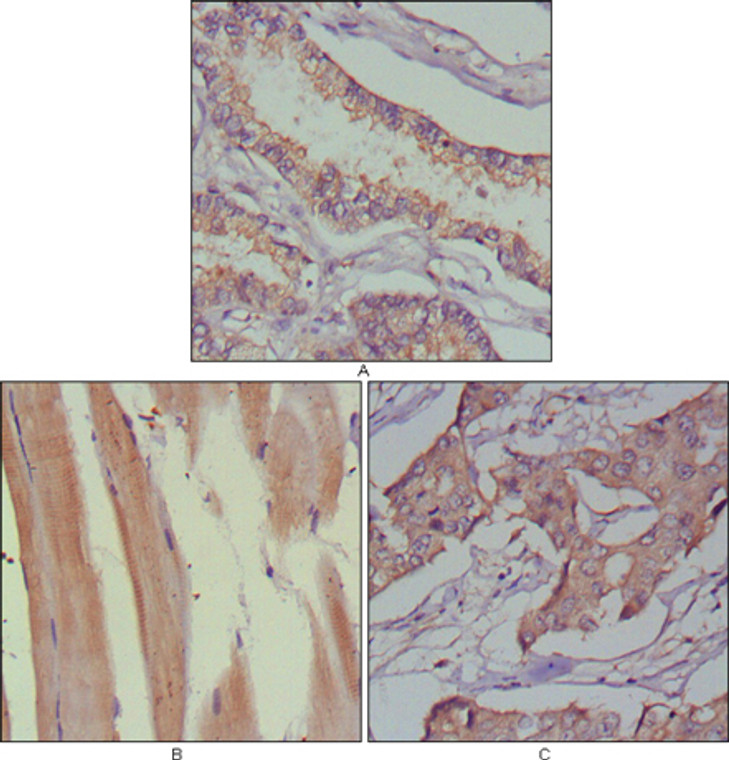| Host: |
Mouse |
| Applications: |
IHC/IF/ELISA |
| Reactivity: |
Human |
| Note: |
STRICTLY FOR FURTHER SCIENTIFIC RESEARCH USE ONLY (RUO). MUST NOT TO BE USED IN DIAGNOSTIC OR THERAPEUTIC APPLICATIONS. |
| Short Description: |
Mouse monoclonal antibody anti-Muscle, skeletal receptor tyrosine-protein kinase (24-209 aa) is suitable for use in Immunohistochemistry, Immunofluorescence and ELISA research applications. |
| Clonality: |
Monoclonal |
| Clone ID: |
10A4 |
| Conjugation: |
Unconjugated |
| Isotype: |
IgG1 |
| Formulation: |
Liquid in PBS containing 0.03% Sodium Azide, 0.5% BSA, 50% Glycerol. |
| Purification: |
Affinity purification |
| Dilution Range: |
IHC 1:200-1:1000IF 1:200-1:1000ELISA 1:10000 |
| Storage Instruction: |
Store at-20°C for up to 1 year from the date of receipt, and avoid repeat freeze-thaw cycles. |
| Gene Symbol: |
MUSK |
| Gene ID: |
4593 |
| Uniprot ID: |
MUSK_HUMAN |
| Immunogen Region: |
24-209 aa |
| Specificity: |
MuSK Monoclonal Antibody detects endogenous levels of MuSK protein. |
| Immunogen: |
Purified recombinant extracellular fragment of human MuSK (aa24-209) fused with hIgGFc tag expressed in HEK293 cell line. |
| Function | Receptor tyrosine kinase which plays a central role in the formation and the maintenance of the neuromuscular junction (NMJ), the synapse between the motor neuron and the skeletal muscle. Recruitment of AGRIN by LRP4 to the MUSK signaling complex induces phosphorylation and activation of MUSK, the kinase of the complex. The activation of MUSK in myotubes regulates the formation of NMJs through the regulation of different processes including the specific expression of genes in subsynaptic nuclei, the reorganization of the actin cytoskeleton and the clustering of the acetylcholine receptors (AChR) in the postsynaptic membrane. May regulate AChR phosphorylation and clustering through activation of ABL1 and Src family kinases which in turn regulate MUSK. DVL1 and PAK1 that form a ternary complex with MUSK are also important for MUSK-dependent regulation of AChR clustering. May positively regulate Rho family GTPases through FNTA. Mediates the phosphorylation of FNTA which promotes prenylation, recruitment to membranes and activation of RAC1 a regulator of the actin cytoskeleton and of gene expression. Other effectors of the MUSK signaling include DNAJA3 which functions downstream of MUSK. May also play a role within the central nervous system by mediating cholinergic responses, synaptic plasticity and memory formation. |
| Protein Name | Muscle - Skeletal Receptor Tyrosine-Protein KinaseMuscle-Specific Tyrosine-Protein Kinase ReceptorMuskMuscle-Specific Kinase Receptor |
| Database Links | Reactome: R-HSA-3000178 |
| Cellular Localisation | Postsynaptic Cell MembraneSingle-Pass Type I Membrane ProteinColocalizes With Acetylcholine Receptors (Achr) To The Postsynaptic Cell Membrane Of The Neuromuscular Junction |
| Alternative Antibody Names | Anti-Muscle - Skeletal Receptor Tyrosine-Protein Kinase antibodyAnti-Muscle-Specific Tyrosine-Protein Kinase Receptor antibodyAnti-Musk antibodyAnti-Muscle-Specific Kinase Receptor antibodyAnti-MUSK antibody |
Information sourced from Uniprot.org
12 months for antibodies. 6 months for ELISA Kits. Please see website T&Cs for further guidance








